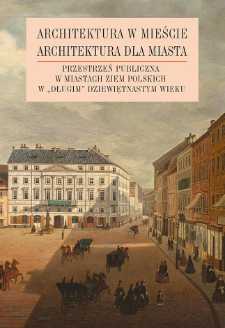
Object
Title: Łódź – miasto bez centrum?
Subtitle:
Architektura w mieście, architektura dla miasta : przestrzeń publiczna w miastach ziem polskich w "długim" dziewiętnastym wieku ; Zabór rosyjski
Contributor:
Łupienko, Aleksander (1980– ) : Redaktor ; Zabłocka-Kos, Agnieszka (1957– ) : Redaktor ; Polska Akademia Nauk. Instytut Historii im. Tadeusza Manteuffla
Publisher:
Place of publishing:
Description:
s. 279-293 : il. (w tym kolorowe) ; 24 cm ; Abstrakt w języku angielskim.
Type of object:
Abstract:
The urban layout of the city of Łódź developed in the 1820s, when new industrial settlements were being established. The urban landscape created at that time consisted of three main parts: the Old Town, New Town, and Łódka, connected by the main meridional artery called Piotrkowska Street. The centre was to be formed with the New Market Square, an octagonal square at the axis of Piotrkowska Street in the central part of the New Town. It was to be given a representative character by two buildings: City Hall and the Augsburg Evangelical Church of the Holy Trinity, with a school added at a later time. However, the north-south elongation of the city, characteristic of Łódź, and the location of the New Market Square in its northern part, while the main industrial plants were clustered in the southern part, prevented the Market from becoming the city centre. During the dynamic development of the city in the last quarter of the nineteenth century, the city centre as such began to crystalize at the middle section of Piotrkowska Street, under the strong influence of a new railway station being built in the neighbourhood of Łódź-Fabryczna. What was also important were investments by private entrepreneurs. Nevertheless, the area along the busy street lacked some elements essential for a city centre. There was no free space, no square for public gatherings, and no representative, monumental public buildings. In consequence, neither location became a city centre in the full sense of the word. In general, this situation has not changed today. Periods of reconstruction throughout the twentieth century, both in the interwar years and after 1945, have not borne fruit. In addition, the attempt in 2010 to create a New Centre of Łódź also ended in failure.
Start page:
End page:
Detailed Resource Type:
Resource Identifier:
oai:rcin.org.pl:140640 ; 978-83-65880-53-6
Source:
IH PAN, sygn. II.14682 ; IH PAN, sygn. II.14681 Podr. ; click here to follow the link
Language:
Language of abstract:
Rights:
Licencja Creative Commons Uznanie autorstwa-Bez utworów zależnych 4.0
Terms of use:
Zasób chroniony prawem autorskim. [CC BY-ND 4.0 Międzynarodowe] Korzystanie dozwolone zgodnie z licencją Creative Commons Uznanie autorstwa-Bez utworów zależnych 4.0, której pełne postanowienia dostępne są pod adresem: ; -
Digitizing institution:
Instytut Historii Polskiej Akademii Nauk
Original in:
Biblioteka Instytutu Historii PAN
Access:
Object collections:
- Digital Repository of Scientific Institutes > Partners' collections > Institute of History PAS > Books
- Digital Repository of Scientific Institutes > Partners' collections > Institute of History PAS > Institute Publications
- Digital Repository of Scientific Institutes > Partners' collections > Institute of History PAS > Institute Publications > Books
- Digital Repository of Scientific Institutes > Literature > Books/Chapters
Last modified:
Oct 2, 2020
In our library since:
Sep 23, 2020
Number of object content downloads / hits:
465
All available object's versions:
https://rcin.org.pl/publication/175670
Show description in RDF format:
Show description in RDFa format:
Show description in OAI-PMH format:
| Edition name | Date |
|---|---|
| Stefański, Krzysztof (1955- ), Łódź – miasto bez centrum? | Oct 2, 2020 |
Objects Similar
Kaufmann, Petra Radeljak Kliček, Slaven Bišćević, Filip Dokupil, Dino Jašinski, Davorin Begonja, Marijan Harjač, Doroteja Bosanac, Tamara Komes, Silvija Borčić, Lana Slavuj Stančec, Marko Zuanović, Mislav Korpar, Linda
Stefański, Krzysztof (1955– )

 INSTYTUT ARCHEOLOGII I ETNOLOGII POLSKIEJ AKADEMII NAUK
INSTYTUT ARCHEOLOGII I ETNOLOGII POLSKIEJ AKADEMII NAUK
 INSTYTUT BADAŃ LITERACKICH POLSKIEJ AKADEMII NAUK
INSTYTUT BADAŃ LITERACKICH POLSKIEJ AKADEMII NAUK
 INSTYTUT BADAWCZY LEŚNICTWA
INSTYTUT BADAWCZY LEŚNICTWA
 INSTYTUT BIOLOGII DOŚWIADCZALNEJ IM. MARCELEGO NENCKIEGO POLSKIEJ AKADEMII NAUK
INSTYTUT BIOLOGII DOŚWIADCZALNEJ IM. MARCELEGO NENCKIEGO POLSKIEJ AKADEMII NAUK
 INSTYTUT BIOLOGII SSAKÓW POLSKIEJ AKADEMII NAUK
INSTYTUT BIOLOGII SSAKÓW POLSKIEJ AKADEMII NAUK
 INSTYTUT CHEMII FIZYCZNEJ PAN
INSTYTUT CHEMII FIZYCZNEJ PAN
 INSTYTUT CHEMII ORGANICZNEJ PAN
INSTYTUT CHEMII ORGANICZNEJ PAN
 INSTYTUT FILOZOFII I SOCJOLOGII PAN
INSTYTUT FILOZOFII I SOCJOLOGII PAN
 INSTYTUT GEOGRAFII I PRZESTRZENNEGO ZAGOSPODAROWANIA PAN
INSTYTUT GEOGRAFII I PRZESTRZENNEGO ZAGOSPODAROWANIA PAN
 INSTYTUT HISTORII im. TADEUSZA MANTEUFFLA POLSKIEJ AKADEMII NAUK
INSTYTUT HISTORII im. TADEUSZA MANTEUFFLA POLSKIEJ AKADEMII NAUK
 INSTYTUT JĘZYKA POLSKIEGO POLSKIEJ AKADEMII NAUK
INSTYTUT JĘZYKA POLSKIEGO POLSKIEJ AKADEMII NAUK
 INSTYTUT MATEMATYCZNY PAN
INSTYTUT MATEMATYCZNY PAN
 INSTYTUT MEDYCYNY DOŚWIADCZALNEJ I KLINICZNEJ IM.MIROSŁAWA MOSSAKOWSKIEGO POLSKIEJ AKADEMII NAUK
INSTYTUT MEDYCYNY DOŚWIADCZALNEJ I KLINICZNEJ IM.MIROSŁAWA MOSSAKOWSKIEGO POLSKIEJ AKADEMII NAUK
 INSTYTUT PODSTAWOWYCH PROBLEMÓW TECHNIKI PAN
INSTYTUT PODSTAWOWYCH PROBLEMÓW TECHNIKI PAN
 INSTYTUT SLAWISTYKI PAN
INSTYTUT SLAWISTYKI PAN
 SIEĆ BADAWCZA ŁUKASIEWICZ - INSTYTUT TECHNOLOGII MATERIAŁÓW ELEKTRONICZNYCH
SIEĆ BADAWCZA ŁUKASIEWICZ - INSTYTUT TECHNOLOGII MATERIAŁÓW ELEKTRONICZNYCH
 MUZEUM I INSTYTUT ZOOLOGII POLSKIEJ AKADEMII NAUK
MUZEUM I INSTYTUT ZOOLOGII POLSKIEJ AKADEMII NAUK
 INSTYTUT BADAŃ SYSTEMOWYCH PAN
INSTYTUT BADAŃ SYSTEMOWYCH PAN
 INSTYTUT BOTANIKI IM. WŁADYSŁAWA SZAFERA POLSKIEJ AKADEMII NAUK
INSTYTUT BOTANIKI IM. WŁADYSŁAWA SZAFERA POLSKIEJ AKADEMII NAUK


































